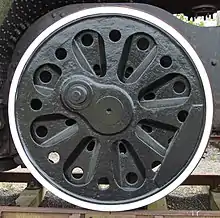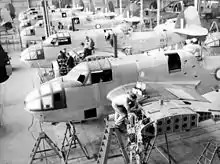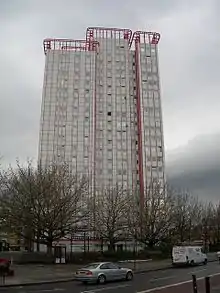Lightening holes
Lightening holes are holes in structural components of machines and buildings used by a variety of engineering disciplines to make structures lighter. The edges of the hole may be flanged to increase the rigidity and strength of the component.[1] The holes can be circular, triangular, elliptical, or rectangular and should have rounded edges, but they should never have sharp corners, to avoid the risk of stress risers, and they must not be too close to the edge of a structural component.[2][3]

Usage
Aviation

Lightening holes are often used in the aviation industry. This allows the aircraft to be lightweight as possible, retaining the durability and airworthiness of the aircraft structure.[4][5]
Maritime
Lightening holes have also been used in marine engineering to increase seaworthiness of the vessel.[6][7][8]
Motorsports
.jpg.webp)
Lightening holes became a prominent feature of motor racing in the 1920s and 1930s. Chassis members, suspension components, engine housings and even connecting rods were drilled with a range of holes, of sizes almost as large as the component.
"[The] wisdom of the day was to make everything along the lines of a brick shithouse [...] and then drill holes in the bits to lighten them."
This drive towards lightening was based on a misunderstanding of the component's mechanical behaviour. The assumption for an H-beam was that all of the resistance to bending stresses was carried in the two top and bottom flanges of the girder, with the central web only carrying out a spacing function. The central web could thus be drilled indiscriminately, supposedly without weakening the overall girder. This was based on two fallacies: firstly that the only forces on the beam were simple bending forces in the plane of the web. In practice, a more complicated force, such as an unexpected torsional twisting from a sudden suspension bump overloaded the now-weakened central web and the lightened beam failed immediately. Secondly, the assumption that the ideal forces were separated into the top and bottom flanges was increasingly unrealistic with the development of stressed skin and monocoque designs, where loads were more evenly shared. In these designs there was no "unloaded web" that could be safely drilled.
In comparison to aircraft design, it was notable that motor racing lightening was carried out after the design of the components, usually without understanding the forces in the structure and without re-performing any stress calculations afterwards. Owing to the increasing number of dangerous failures, the practice of drilling lightening holes was forbidden by the race scrutineers. Lightening was still permitted, but only where it had been specified by the original designers, not by simply drilling holes afterwards.
Military
Lightening holes have been used in various military vehicles, aircraft, equipment and weaponry platforms. This allows equipment to be lighter in weight as well as increase the ruggedness and durability. They are usually made by drilling holes, pressed stamping or machining and can also save strategic materials and cost during wartime production.
Architecture

Lightening holes have been used on various architecture designs.[10] During the 1980s and early 1990s, Lightening holes were fashionable and somewhat seen as futuristic and were used in the likes of industrial units, car showrooms, shopping precincts, sports centres etc. Parsons House in London is a notable building that uses lightening holes since its renovation in 1988.[11][12] Ringwood Health & Leisure Centre in Hampshire is another notable example.[13][14]
References
- Fournier, Ron; Fournier, Sue (1989). Sheet Metal Handbook. HPBooks. p. 25. ISBN 9780895867575. Retrieved 2012-06-08.
-
Gerr, Dave (2000). The Elements of Boat Strength: For Builders, Designers, and Owners. International Marine. p. 322. Retrieved 2012-06-08.
lightening hole.
- "Chapter 2: Holes - Modeling the Effect of Damage in Composite Structures: Simplified Approaches [Book]". www.oreilly.com.
- "Sheet metal structure".
- "ANC-18". Flysafe.raa.asn.au. Retrieved 2019-07-14.
- "Midship constructions". February 4, 2014.
- "SEAWORTHINESS ASSIGNMENT CONSTRUCTION". www.splashmaritime.com.au.
- "Designing A Ship's Bottom Structure – A General Overview". July 13, 2015.
- Ludvigsen, Karl (2010). Colin Chapman: Inside the Innovator. Haynes Publishing. p. 150. ISBN 978-1-84425-413-2.
- "INNOVATIONS - Metalstroi Stoianov & Georgiev Ltd. – Manufacturing and assembling metal constructions". Metalstroi-s-g.com. Retrieved 2019-07-14.
- "Archived copy". Archived from the original on 2015-05-15. Retrieved 2017-04-05.CS1 maint: archived copy as title (link)
- "Parsons House, London - Building #2077". www.skyscrapernews.com.
- "Website Builder | Simple & Easy To Use | UK2". Pgparchitects.co.uk. Retrieved 2019-07-14.
- "Photo" (JPG). c2.staticflickr.com. Retrieved 2019-07-14.
External links
| Wikimedia Commons has media related to Lightening holes. |
- Tests Of Beams Having Webs With Large Circular Lightening Holes, by L. Ross Levin, National Advisory Committee for Aeronautics
- The Strength And Stiffness Of Shear Webs With And Without Lightening Holes, by Paul Kuhn, National Advisory Committee for Aeronautics
- The Strength And Stiffness Of Shear Webs With Round Lightening Holes Having 45° Flanges, by Paul Kuhn, National Advisory Committee for Aeronautics
